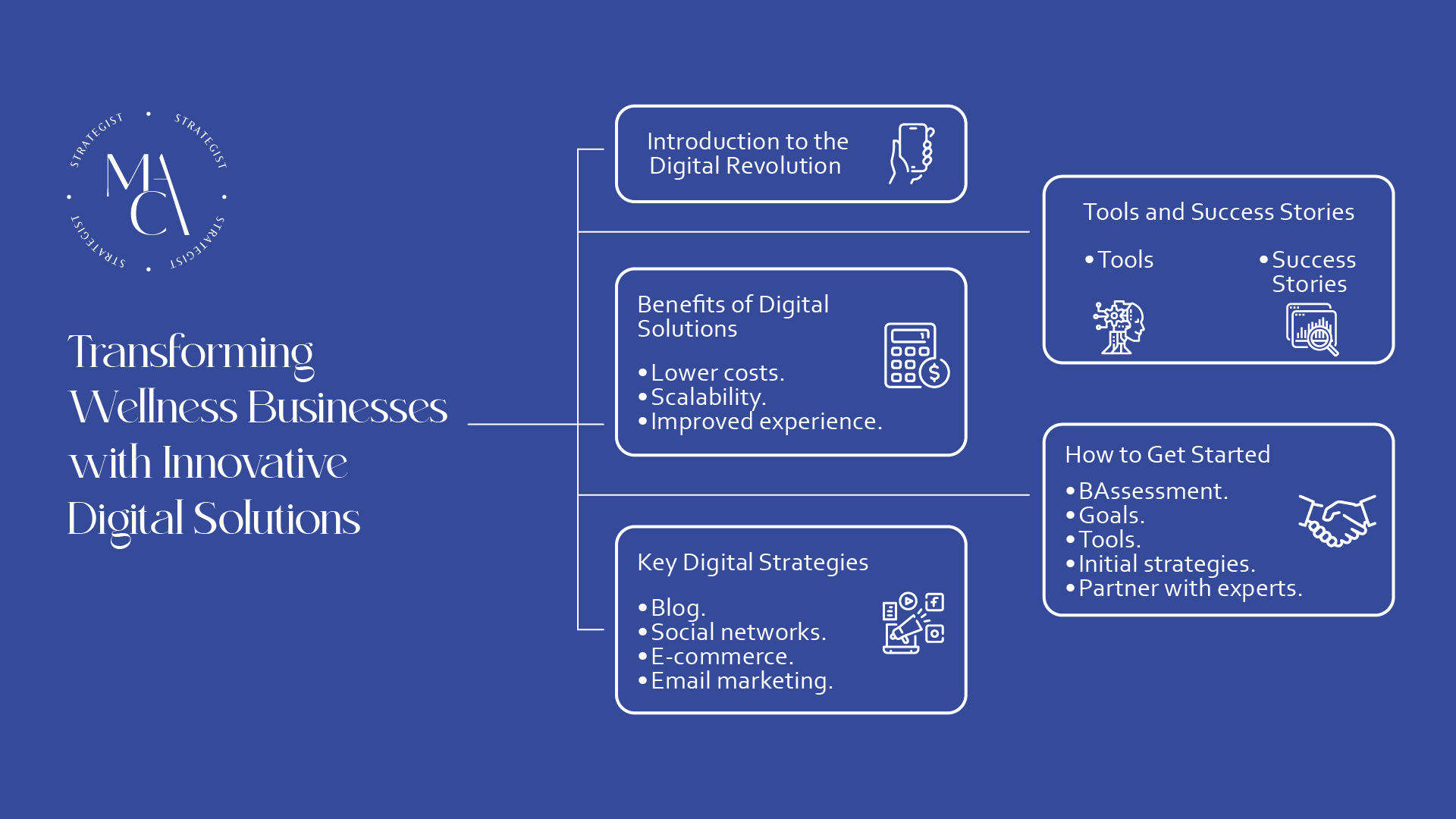1. The Digital Revolution in Wellness
The wellness industry is no stranger to evolution, but the digital revolution has taken transformation to an entirely new level. In a world where technology drives nearly every aspect of our lives, wellness businesses have embraced tools and strategies that go far beyond traditional methods. The result? A more connected, efficient, and impactful approach to promoting health and well-being.
Digital Tools Redefining Wellness
From wearable technology to personalized wellness apps, digital tools have reshaped how people approach their health. Devices like Fitbit and Apple Watch have made it easier than ever to monitor fitness goals, track sleep patterns, and even manage stress levels. These tools empower users to take charge of their wellness journey while providing businesses with valuable insights into consumer behavior.
Personalized wellness apps are another game-changer. Platforms like MyFitnessPal and Calm use data-driven algorithms to tailor experiences, offering everything from custom meal plans to guided meditations. This personalization fosters a sense of connection and loyalty, which is invaluable for wellness brands.
Staying Competitive with Innovation
The wellness market is growing rapidly, projected to exceed $7 trillion globally by 2025 (Global Wellness Institute). However, with growth comes competition. Businesses that fail to adapt risk falling behind. By embracing NY digital wellness services, wellness brands can leverage the latest tools and strategies to stay ahead of the curve.

Examples of Digital Trends
- Online Fitness Classes: Platforms like Peloton have revolutionized how people work out, combining live-streamed classes with community engagement.
- Wearable Tech: Beyond fitness tracking, devices now measure stress, hydration, and even blood pressure, opening new doors for wellness monitoring.
- Telehealth and Virtual Consultations: Wellness professionals, from nutritionists to therapists, are using digital platforms to reach clients anywhere in the world.
The digital revolution is not a trend—it’s a necessity for wellness businesses looking to thrive in an increasingly tech-savvy world.
2. Why Digital Solutions Matter for Wellness Businesses
Digital solutions have fundamentally changed the way wellness brands interact with their audiences. In an industry that thrives on trust and connection, leveraging digital tools is not just about convenience—it’s about creating meaningful relationships.
Deeper Connections with Health-Conscious Audiences
Health-conscious consumers crave authenticity. They want brands that understand their unique challenges and offer tailored solutions. Digital tools enable wellness businesses to engage directly with their audience, offering personalized content and services that build trust.
For example, a yoga studio might use email campaigns to share mindfulness tips, while a fitness brand could provide personalized workout recommendations through an app. These interactions create a sense of partnership, making customers feel valued and understood.
The Role of Data in Customer Understanding
Data is the backbone of effective digital marketing. Platforms like Google Analytics and customer relationship management (CRM) tools allow businesses to track user behavior, identify trends, and tailor their offerings accordingly. This data-driven approach ensures that wellness brands deliver the right message to the right audience at the right time.
Benefits of Digital Solutions
- Cost-Efficiency: Digital marketing tools often provide better ROI compared to traditional advertising methods.
- Scalability: From local gyms to global wellness apps, digital strategies can scale to meet any brand’s needs.
- Enhanced Customer Experience: Personalized communication, seamless booking systems, and online consultations make it easier than ever for customers to engage with wellness services.
Embracing digital solutions like NY digital wellness services ensures that wellness businesses remain competitive while meeting the evolving needs of their audience.
3. Key Digital Strategies for Wellness Businesses
To thrive in today’s market, wellness businesses need a robust digital strategy. Here are the key approaches driving success:
SEO and Content Marketing
Search engine optimization (SEO) ensures that your business is easily discoverable online. High-quality, value-driven content—like blogs, videos, and infographics—helps attract and retain audiences by providing solutions to their problems. For instance, an article on “10 Yoga Poses to Relieve Stress” not only builds trust but positions your brand as an authority in the wellness space.
Social Media Marketing
Platforms like Instagram, TikTok, and Facebook are ideal for wellness brands to connect with their communities. Sharing visually engaging content, hosting live Q&A sessions, and collaborating with influencers can help boost visibility and foster a sense of belonging.
Personalized Email Campaigns
Email remains one of the most effective marketing tools. By segmenting your audience and tailoring content, you can build loyalty and drive repeat business. For example, a spa might send birthday discounts or recommend treatments based on previous visits.
E-Commerce for Wellness Products
Wellness businesses offering products like supplements or fitness equipment can expand their reach through online sales platforms. User-friendly e-commerce sites and targeted ads can drive sales while creating a seamless shopping experience for customers.
By integrating these strategies into their marketing efforts, wellness businesses can build strong connections with their audience and achieve sustainable growth.
4. Innovative Tools Transforming Wellness Marketing
Digital tools are evolving rapidly, offering wellness businesses new ways to engage their audience and streamline operations. Here are some of the most transformative innovations:
AI and Automation
Artificial intelligence (AI) has revolutionized marketing by enabling personalized recommendations, chatbots, and automated email campaigns. For example, a chatbot can answer customer queries 24/7, while AI-driven analytics can suggest content based on user preferences.
Virtual and Augmented Reality (VR/AR)
VR and AR are creating immersive experiences for wellness audiences. Imagine offering virtual tours of a wellness retreat or using AR to demonstrate yoga poses. These technologies not only engage customers but also differentiate brands in a crowded market.
Data Analytics Platforms
Tools like HubSpot and Tableau allow wellness businesses to track campaign performance, measure ROI, and gain insights into customer behavior. This data-driven approach ensures that every marketing effort delivers maximum impact.
Telehealth and Online Consultations
For wellness professionals, digital platforms like Zoom and Doxy.me enable seamless virtual consultations. This not only expands their reach but also offers convenience for clients.
The right tools, combined with expert guidance from NY digital wellness services, can transform the way wellness businesses market themselves, creating opportunities for growth and innovation.
Digital innovation is no longer optional for wellness businesses—it’s essential. By leveraging tools and strategies tailored to their unique needs, wellness brands can connect with their audiences, build trust, and drive growth in an increasingly competitive market. Embracing this transformation ensures not only survival but success in a rapidly changing world.
5. Real-World Success Stories
Digital innovation has reshaped the wellness industry, creating opportunities for brands to connect with audiences in ways that were once unimaginable. Many wellness businesses that embraced cutting-edge strategies have seen measurable growth, proving the power of digital transformation.
Success Story #1: Boutique Yoga Studio Boosts Engagement Through Influencer Marketing
A boutique yoga studio in New York City partnered with local wellness influencers to promote their online classes. By leveraging influencer marketing, they reached thousands of potential customers on Instagram and TikTok. The influencers shared authentic experiences through live streams and short videos, showcasing the studio’s unique class offerings. Within three months, the studio saw a 35% increase in new sign-ups, and their online community expanded exponentially.
Success Story #2: Gamification Drives Retention for a Fitness App
A fitness app implemented gamification to boost user engagement. By introducing daily challenges, rewards for milestones, and leaderboards, the app encouraged users to stay consistent with their fitness goals. This strategy led to a 40% increase in user retention and attracted over 50,000 new downloads within six months.
**Success Story #3: Wellness Retreat Expands Reach with NY Digital Wellness Services
A wellness retreat in upstate New York collaborated with MACA Strategist to revamp their digital presence. Through targeted ads, SEO, and an engaging email marketing campaign, the retreat saw a 60% increase in bookings, with many clients citing the digital content as their introduction to the brand.
These examples highlight the tangible benefits of embracing digital innovation. By leveraging strategies like influencer marketing, gamification, and expert digital services, wellness brands can unlock unprecedented growth.
For additional insights into successful digital marketing campaigns, explore case studies from the American Marketing Association, a valuable resource for industry leaders.
6. Challenges Wellness Businesses Face in Going Digital
While the rewards of digital transformation are undeniable, the journey is not without its hurdles. Wellness businesses face several challenges in adopting and integrating digital solutions, but with the right approach, these barriers can be overcome.
Common Challenges
- Lack of Expertise: Many wellness businesses lack the technical knowledge to implement and manage digital tools effectively. Without proper training or support, even the most advanced tools can go underutilized.
- High Initial Investment: Digital transformation often requires upfront costs for software, equipment, and training. This can be daunting, particularly for smaller businesses.
- Integration Issues: Introducing new tools while maintaining existing systems can lead to inefficiencies if not done carefully. Integration challenges often discourage businesses from adopting new technologies.
- Resistance to Change: Some teams may be hesitant to embrace digital tools, fearing disruption to established workflows.
How to Overcome These Barriers
- Strategic Planning: Start with a clear roadmap that outlines goals, required tools, and timelines. Prioritize initiatives that offer the highest ROI to build momentum.
- Partner with Experts: Collaborating with professionals like NY digital wellness services ensures access to expertise and customized solutions.
- Invest in Training: Providing team members with the necessary skills to use digital tools fosters confidence and maximizes efficiency.
- Adopt Scalable Solutions: Choose tools and platforms that can grow with your business, ensuring long-term sustainability.
For guidance on managing digital transformation, the Small Business Administration (SBA) offers free resources to help small businesses navigate these changes effectively.
7. How to Get Started with Digital Transformation
Digital transformation may feel overwhelming, but starting with small, strategic steps can lead to significant results. Here’s how wellness businesses can begin their journey:
Step 1: Assess Your Digital Readiness
Evaluate your current digital presence. Do you have a website? Are you active on social media? How effectively are you leveraging data? Understanding where you stand helps identify gaps and prioritize improvements.
Step 2: Define Clear Goals
Set specific, measurable objectives. For example, aim to increase website traffic by 50% in six months or double your email subscriber list by the end of the year. These goals will guide your strategy.
Step 3: Choose the Right Tools and Platforms
Select tools that align with your business needs. For example:
- Use Google Analytics to track website performance.
- Leverage Mailchimp for email marketing.
- Adopt Shopify for e-commerce if you sell wellness products.
Step 4: Focus on High-Impact Strategies
Start with initiatives that yield quick wins, such as improving SEO, creating engaging content, or running targeted social media ads.
Step 5: Partner with Experts
Collaborate with professionals like NY digital wellness services to implement and manage advanced strategies. Their expertise can save time and ensure optimal results.
For additional tips on digital transformation, consult resources from the Digital Marketing Institute, a leading authority in the field.
8. The Future of Wellness Businesses in the Digital Age
The digital age has only begun to revolutionize the wellness industry. Businesses that adapt quickly will not only survive but thrive as industry leaders.
Emerging Trends
- AI-Driven Wellness Coaching: Artificial intelligence is enabling personalized wellness coaching, offering tailored advice based on user data. Apps powered by AI will become the norm, delivering unparalleled customization.
- Blockchain for Health Data: Blockchain technology is set to enhance data security and transparency, enabling clients to safely share health information with wellness providers.
- Virtual Reality Wellness Experiences: VR will offer immersive experiences, such as virtual wellness retreats and guided meditation sessions, creating new revenue streams.
- Sustainability in Digital Marketing: Eco-conscious consumers will demand sustainable practices, pushing brands to adopt greener technologies and marketing approaches.
Why Early Adopters Win
Businesses that embrace these trends early will gain a competitive advantage. By staying ahead of the curve, they can attract forward-thinking consumers, establish industry authority, and create innovative offerings that set them apart.
A Call to Action
The time to act is now. As the wellness industry evolves, digital transformation is no longer optional—it’s essential. Partnering with experts like NY digital wellness services ensures your business is equipped to navigate this change successfully.
For more insights into the future of wellness and technology, explore thought leadership from the World Economic Forum, which frequently highlights trends shaping global industries.
Digital transformation is not just a strategy; it’s a necessity for wellness businesses seeking to thrive in the modern era. By learning from success stories, overcoming challenges, and embracing emerging trends, wellness brands can secure their place as leaders in the digital age. The future is digital—let’s step into it together.








